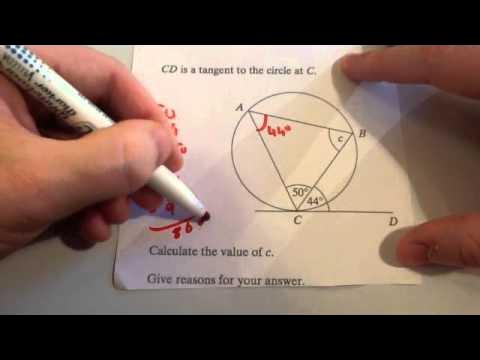ANGLE THEOREMS - Top 10 Must Know
Summary
TLDRThis video covers the top 10 essential angle theorems that are crucial for geometry students. Key topics include complementary and supplementary angles, the sum of angles in triangles and polygons, and important triangle theorems like the isosceles triangle and exterior angle theorems. The video also explains parallel line theorems, such as alternate, co-interior, and corresponding angles, along with key circle theorems. Through examples and illustrations, the video offers practical applications of each theorem, helping viewers understand and apply these fundamental concepts in geometry.
Takeaways
- 😀 Complementary angles are two angles that add up to 90°. Example: 70° + 20° = 90°.
- 😀 Supplementary angles are two angles that add up to 180°. Example: 70° + 110° = 180°.
- 😀 The sum of the angles in any triangle is always 180°. Example: 70° + 75° + 35° = 180°.
- 😀 To calculate the sum of interior angles of a polygon, use the formula (n-2) * 180°, where n is the number of sides. Example: For a pentagon, 5 sides gives 540°.
- 😀 The sum of the exterior angles of any polygon is always 360°.
- 😀 In an isosceles triangle, if two sides are congruent, the angles opposite those sides are also congruent.
- 😀 The exterior angle theorem states that an exterior angle of a triangle is equal to the sum of the two opposite interior angles.
- 😀 Vertical angles are always equal when two lines intersect. Example: If one angle is 61°, the opposite angle is also 61°.
- 😀 Alternate interior angles are equal when two parallel lines are cut by a transversal. Example: Alternate angles are 110° on opposite sides of the transversal.
- 😀 The angle at the center of a circle is twice the angle subtended at the circumference by the same arc. Example: If the central angle is 142°, the angle at the circumference is 71°.
Q & A
What are complementary angles and how do you calculate them?
-Complementary angles are two angles that add up to 90°. To calculate an unknown complementary angle, subtract the known angle from 90°. For example, if one angle is 70°, the other angle will be 90° - 70° = 20°.
What are supplementary angles and how do you calculate them?
-Supplementary angles are two angles that add up to 180°. To calculate an unknown supplementary angle, subtract the known angle from 180°. For example, if one angle is 70°, the other angle will be 180° - 70° = 110°.
What is the sum of the interior angles of a triangle?
-The sum of the interior angles of any triangle is always 180°. This means that if you know two angles in a triangle, you can subtract their sum from 180° to find the third angle.
How do you calculate the sum of the interior angles of a polygon?
-To calculate the sum of the interior angles of a polygon, use the formula (n - 2) * 180°, where 'n' is the number of sides in the polygon. For example, for a pentagon (5 sides), the sum of the interior angles would be (5 - 2) * 180° = 540°.
What is the relationship between the exterior angles of a polygon?
-The sum of the exterior angles of any polygon is always 360°. This holds true regardless of the number of sides in the polygon.
What does the Isosceles Triangle Theorem state?
-The Isosceles Triangle Theorem states that if two sides of a triangle are congruent, then the angles opposite those sides must also be congruent. For example, if two sides of a triangle are equal, the angles opposite those sides will also be equal.
What is the Exterior Angle Theorem?
-The Exterior Angle Theorem states that the exterior angle of a triangle is equal to the sum of the two opposite interior angles. For example, if the exterior angle is 110° and the two opposite interior angles are 40° and 70°, their sum would be 110°.
What does the Vertical Angle Theorem state?
-The Vertical Angle Theorem states that when two lines intersect, the opposite angles formed are equal in measure. For example, if one angle is 61°, the opposite angle will also be 61°.
What are alternate angles and how do they relate to parallel lines?
-Alternate angles are angles formed when two parallel lines are cut by a transversal. Alternate interior angles and alternate exterior angles are always equal. For example, if two parallel lines are intersected by a transversal, alternate interior angles on opposite sides of the transversal are congruent.
What does the Angle at the Center versus Angle at the Circumference rule state?
-The Angle at the Center rule states that the angle subtended by an arc at the center of a circle is twice the angle subtended by the same arc at any point on the circumference. For example, if the angle at the center is 142°, the angle on the circumference will be 71°.
Outlines

このセクションは有料ユーザー限定です。 アクセスするには、アップグレードをお願いします。
今すぐアップグレードMindmap

このセクションは有料ユーザー限定です。 アクセスするには、アップグレードをお願いします。
今すぐアップグレードKeywords

このセクションは有料ユーザー限定です。 アクセスするには、アップグレードをお願いします。
今すぐアップグレードHighlights

このセクションは有料ユーザー限定です。 アクセスするには、アップグレードをお願いします。
今すぐアップグレードTranscripts

このセクションは有料ユーザー限定です。 アクセスするには、アップグレードをお願いします。
今すぐアップグレード関連動画をさらに表示

⭕ Semelhança de Triângulos - GEOMETRIA PLANA (Aula 12)

TANGENTS AND SECANTS OF A CIRCLE || GRADE 10 MATHEMATICS Q2

Teorema Sudut dalam Lingkaran

Triangle Congruence Theorems Explained: ASA, AAS, HL

Garis dan Sudut (5) | Hubungan Antar Sudut pada Dua Garis Sejajar | Matematika Kelas 7

Circle Theorems questions - Corbettmaths
5.0 / 5 (0 votes)
